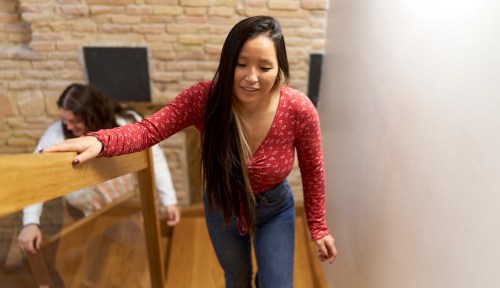I lived in New York City for five years, and for the first two, my work commute took me through Grand Central Station every day. With so many people hustling and bustling about, I’d inevitably have to choose between waiting around for an opening at an escalator or mustering up the energy to carry multiple bags up the stairs. Seeing so many other people do it—and hearing of all the benefits of taking the stairs—I started to opt for the latter.
Experts in This Article
cardiologist and chief medical officer at University of Michigan Health-West
When I moved out of the city, however, daily stair climbs became less of a thing—and I started to feel it. Whenever I did take the stairs, it was pretty obvious how much more winded I was. I also felt like my overall endurance during cardio workouts had changed.
Intrigued by this realization that something as simple as regularly climbing the stairs can drastically impact your cardio health, I set out to uncover the stair climbing benefits that you can get from hiking up a flight (or a few) every day.
Seven things that happen when you take the stairs every day
1.Your heart health improves
One of the biggest stair climbing benefits is its effect on your heart. “Walking up stairs improves heart function and helps your blood pressure,” says cardiologist Ronald G. Grifka, MD, chief medical officer at the University of Michigan Health-West. “There is no question, your cardiovascular system will thank you if you take the stairs.”
2. You feel stronger—especially in your lower body
Your heart isn’t the only thing that will get stronger from taking the stairs every day. “Your skeletal muscles also are better with the exercise, including strength and tone,” Dr. Grifka says. “Going up the stairs stretches your muscles and large joints; it stimulates bone metabolism.”
3. Your bones get stronger
According to the National Institutes of Health Osteoporosis and Related Bone Diseases National Resource Center, climbing the stairs is one of the best exercises you can do for bone health. The reason? When you climb vertically, you’re moving against gravity, which puts a heavier load on your bones and ultimately strengthens them over time.
4. You have better balance
According to a study published in the Scandinavian Journal of Medicine and Science in Sports, researchers found that climbing the stairs significantly boosted balance among healthy seniors. “[It] may contribute to better overall fitness, reduced fall risk, and less perceived strain during daily life activities,” researchers wrote.
5. You have a lower risk of developing metabolic syndrome
According to a 2021 study published in BMC Public Health, researchers found that “daily stair climbing may be protective against metabolic syndrome.” As a refresher, the National Institutes of Health describes metabolic syndrome as a group of conditions that heighten a person’s risk for developing diabetes, stroke, heart disease, and other serious health problems like high blood sugar, high blood pressure, high blood triglycerides, and low levels of HDL cholesterol (aka good cholesterol). Regularly taking the stairs can prevent your risk of developing the syndrome, especially if you’re an adult woman, according to the journal International Journal of Environmental Research and Public Health: Researchers found that “Walking up and down stairs at home reduces health risk at low cost for the individual.”
6. Your stress levels go down
Since climbing the stairs requires more energy than walking on flat surfaces, it also helps to release more endorphins. As a result, Dr. Grifka says that walking up and down stairs can help lower stress levels. “Walking the stairs can provide you some peace of mind and time to reflect on challenges that you have had during the day,” he says. “Also, the sense of accomplishment after climbing a flight of stairs or two can improve your self-perception.”
7. Your longevity could increase
According to a 2021 study published in the Journal of Cachexia, Sarcopenia and Muscle, researchers found that “Climbing more than five flights of stairs at home per day was associated with a lower risk of all‐cause and cancer mortality, compared with those who did not take the stairs.”
But keep in mind…
If you don’t live in a house or apartment building with stairs, or naturally encounter them on your daily commute, you can still get these stair climbing benefits by making a point to choose the stairs over the escalator or elevator when you have the option. Or plan a regular walking route that includes a flight. Or even try doing a stair workout regularly.
Though, know that if you’re not accustomed to taking the stairs, you may feel out of breath when first incorporating the habit into your daily routine. “This is not surprising if you have not done such exercise for a while,” Dr. Grifka says. As your body gets used to the movement, you’ll likely find yourself panting less. “However, ” adds Dr. Grifka, “if the shortness of breath becomes more significant or chest pain occurs, you may want to seek medical attention, just as you would with any exercise.”
Sign Up for Our Daily Newsletter
Get all the latest in wellness, trends, food, fitness, beauty, and more delivered right to your inbox.
Got it, you've been added to our email list.











